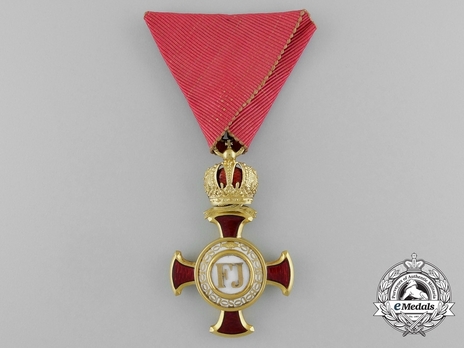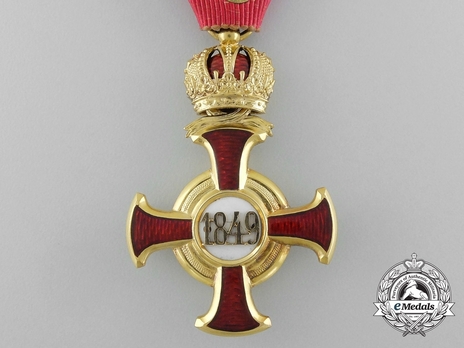Merit Cross "1849", Type II, I Class Cross (with crown)
CATEGORY: Version
SKU: 02.AUT.0108.101.01.000
Estimated market value:




Estimated market value:
An Outstanding & Mint Austrian Merit Cross; 1st Class Gold Cross with Crown
2nd Period with Large Crown (1875-1914), Cased: An absolutely mint example in gold with red and white enamels, hallmarked and maker marked "V. MAYER'S SÖHNE" and "IN WIEN" (V. Mayer's Son, Vienna) on the ring, 35.8 mm x 56.8 mm inclusive of its crown suspension, original triangular ribbon, mint. In its hardshelled case of issue, marked "V. K." over "m. d. K." on the lid, maker marked "V. MAYER'S SÖHNE WIEN" on the inside lid, recessed dark green velvet medal bed, stamped in black ink "1901" with light wear and spotting on the bottom, case extremely fine.
The Imperial Decree of February 16, 1850 announced the creation of the new Cross of Merit to replace the Civil Medals of Honour. This was awarded primarily to civilian achievements. More specifically it was “to reward loyal and actively reliable devotion to Kaiser and Fatherland, long years of fruitful employment in public service or other achievements for the general good.”
The Cross of Merit was originally awarded in four classes, as a ‘gold’ and a ‘silver’ cross each with or without a crown. Multiple awards could be conferred upon the same recipient, and lower levels could still be worn after a higher one was awarded. Women could also be awarded the Cross of Merit, prior to the outbreak of the war.
In September 1914, the Statutes were amended to include soldiers who were away from the front. However, these decorations would be worn on the red and white silk ribbon of the bravery medal. As of February 1916, ‘gold’ crosses were constructed of bronze due to the lack of material during the war.
On April 1, 1916, the “Iron Cross of Merit” was created. It was only to be awarded during the war and only to NCOs. This decoration looked like the gold and silver crosses but used rust-protected iron and was not enamelled. The reverse presents the year 1916. It was awarded to all other ranks and NCOs not in a rank group who were born in 1865 and 1866, who in 1917 were still actively participating in the war were automatically awarded the Iron Cross of Merit. Anyone who had already received this award was provided with a silver bar for the ribbon. In 1918, this provision included the men born in 1867. As the war progressed the composition changed from rust-protected iron to pewter or zinc alloys.
In December 1916, the Decoration could include swords, which indicated achievement in the face of the enemy or in effective leadership of a formation.
In February 1918, it became possible to be awarded the Gold and Silver crosses (with or without crown) more than once, denoted by a gold bar on the ribbon.
The Type I and Type II crosses are worn on red ribbons. The Type II I Class Cross and III Class Cross have a larger surmounting crowns than the awards in Type I. They main manufacturers are Vincent Mayer’s Sohne, Rozet & Fischmeister, Rothe & Neffe.
The inscription VIRIBUS UNITIS translates to “With United Forces.”

Comments
Sign in to comment and reply.


Scroll Top